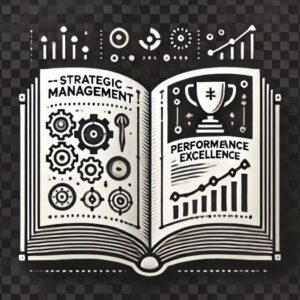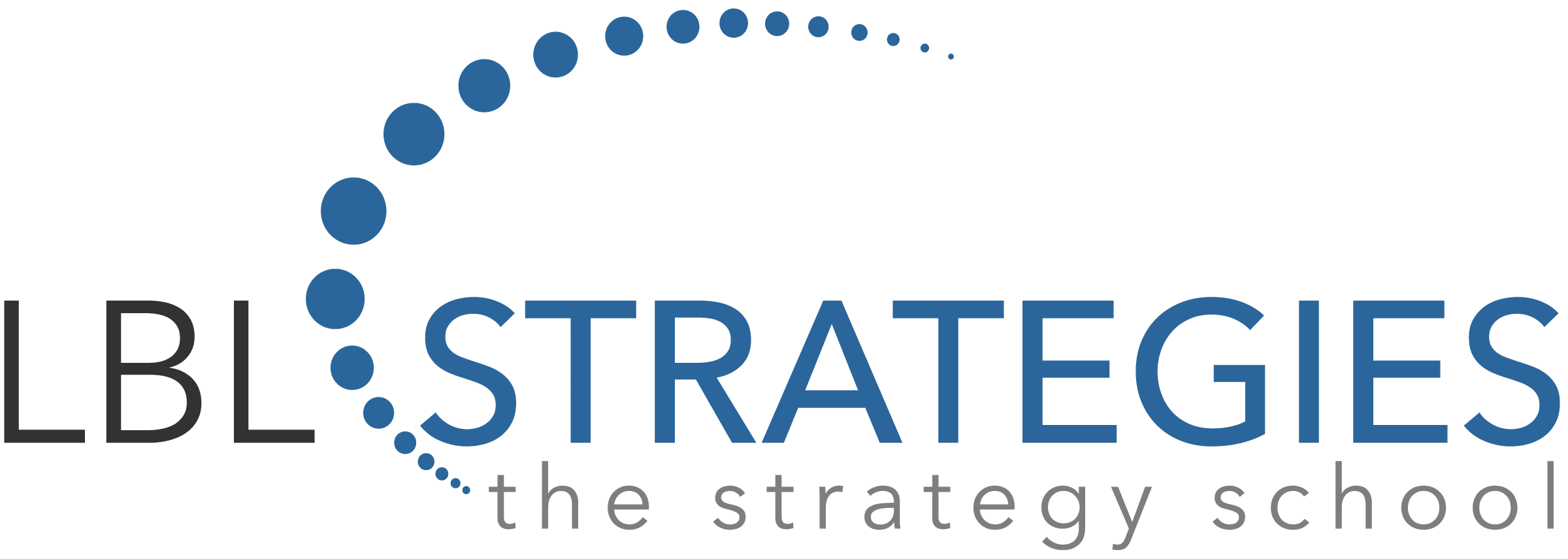By Randall Rollinson and Tamera Fields Parsons
In an earlier post, we proposed the discipline of strategic management, and the Baldrige Excellence Framework are, in fact, “Two Sides of the Same Coin.”
Today’s metaphor is "Two Pages in the Same Book." This metaphor suggests that while two frameworks may seem separate, they are integral to a singular story or purpose. Each page offers a different perspective or set of details, yet they are bound together, contributing to the greater narr

ative. For example, (and from a systems perspective) in a strategic framework, “Strategic Management” and “Performance Excellence” may focus on different aspects—strategy versus execution—but both are chapters in the larger story of organizational success.
Strategy and Performance Excellence professionals who integrate these approaches can unlock synergies that enhance both strategic clarity and operational effectiveness. They are mutually reinforcing, offering complementary frameworks for achieving organizational success.
A critical component of this integration is aligning strategy and priorities with the organization’s operating model, ensuring that the structure, processes, and resources are designed to support the strategy. Failure to align these elements can result in strategic missteps, operational inefficiencies, and suboptimal outcomes.
In this post, we build on that claim and offer a tangible work plan to bring this synergistic proposition into reality.
Strategic Management: A Foundation for Direction and Competitive Advantage
Strategic management provides a comprehensive approach to better understanding the future, analyzing competitive environments, setting organizational direction, and ensuring alignment of resources to achieve long-term goals (Mintzberg et al., 1998). It emphasizes the formulation of a clear vision, mission, and strategy, the identification of key strategic objectives, and the deployment of initiatives to secure competitive advantage. By engaging in activities such as environmental scanning, foresight building, prioritizing via SWOT analysis, and strategic positioning, organizations create a roadmap that guides decision-making and resource allocation (Porter, 1980).
However, even the most robust strategic plans can falter if they are not integrated into the organization’s operating model. For example, if resources, processes, and workflows are misaligned with strategic priorities, execution will suffer. Effective strategic management requires ensuring that organizational structures and operational systems are designed to support and enhance the implementation of strategic goals.
The effectiveness of strategic management often hinges on an organization’s ability to execute and integrate its strategies effectively. This is where the Baldrige Criteria come into play.
Baldrige Performance Excellence Criteria: A Framework for Operational Excellence
The Baldrige Criteria underpin a structured framework designed to evaluate and improve organizational performance across seven critical dimensions: leadership, strategy, customers, measurement, analysis and knowledge management, workforce, operations, and results (NIST, 2021). Originating from a commitment to quality and continuous improvement, the Baldrige Excellence Framework (and criteria questions therein) encourages organizations to adopt a holistic perspective that integrates processes, people, and results.
A key strength of the Baldrige Framework is its focus on aligning operational processes with strategic priorities. By systematically addressing the interplay between strategy and execution, the Baldrige Criteria ensure that organizational efforts are consistent, effective, and adaptable to real-world conditions. For instance, the alignment of customer-focused strategies with operational capabilities not only enhances customer satisfaction but also drives sustainable results.
The Baldrige Criteria focus on systematic approaches, deployment, evaluation, learning, and alignment of processes and outcomes. These principles ensure that strategies and initiatives are not only well-defined but also consistently executed and modified based on real-world performance insights (Evans & Lindsay, 2020).
Our Synergistic Proposition
The discipline of strategic management and the Baldrige Excellence Framework are interdependent in several keyways:
- Strategic Alignment: While strategic management establishes overarching goals and priorities, the Baldrige Excellence Framework ensures these goals are operationalized effectively. The Criteria’s emphasis on systematic processes helps organizations align daily activities and operations with strategic objectives. This alignment extends to the organization’s operating model, ensuring that the design and execution of processes reflect strategic priorities.
- Execution Excellence: Many strategies fail not because they are poorly conceived but because they are poorly executed. The Baldrige Framework’s focus on disciplined execution and feedback mechanisms provides a structure for translating strategic plans into tangible outcomes. Ensuring that the operating model supports seamless execution is vital to closing this gap.
- Continuous Improvement: Strategic management thrives on agility and adaptability, requiring regular assessment and refinement of strategies. The Baldrige Excellence Framework’s measurement, analysis, and learning dimensions offer tools for evaluating performance and identifying areas for improvement, ensuring strategies remain relevant and effective.
- Leadership Integration: Both frameworks emphasize the critical role of leadership. Strategic management relies on visionary leadership teams to chart a course for the future, while the Baldrige Criteria underscore the importance of leadership in fostering a culture of agility and resilience, accountability, learning, innovation, and intelligent risk-taking.
- Focus on Results: Strategic management is inherently results-oriented, aiming to achieve competitive advantage and stakeholder satisfaction. The Baldrige Excellence Framework’s “Results” category complements this focus by ensuring that the outputs and outcomes are systematically monitored, analyzed, aligned, and improved.
For strategy and performance excellence professionals, integrating the Baldrige Excellence Framework with their strategic management practices offers a powerful approach to achieving sustained success. A crucial element of this integration is the alignment of strategic priorities with the operating model, ensuring that resources, processes, and performance systems work in harmony to support long-term goals. Together, these disciplines create a dynamic interplay that fosters resilience, adaptability, and performance excellence in today’s complex organizational environments.
How to Do It
Below is a detailed work plan designed for strategy professionals and performance excellence leaders to adapt to their context and guide this integration.
Phase I - Foundation Building
Objective: Establish a shared understanding of both frameworks and their interdependencies.
Leadership Alignment:
- Conduct executive briefings to ensure alignment on the value and purpose of integrating these frameworks.
- Establish a cross-functional steering committee comprising strategy professionals, performance excellence leaders, and key stakeholders.
- Assess the organization’s current operating model to identify areas of misalignment with strategic goals.
Framework Education:
- Organize workshops to educate teams on strategic management principles and the Baldrige Excellence Framework.
- When available, use case studies to illustrate successful integrations in similar organizations.
Assessment of Current State:
- Conduct a strategic audit to evaluate existing strategies, goals, and resource alignment.
- Perform a Baldrige self-assessment to identify strengths, gaps, and priorities for improvement across the seven criteria.
Integration Vision and Goals:
- Define clear objectives for the integration, such as improving execution, fostering continuous improvement, and enhancing stakeholder satisfaction.
- Develop a high-level roadmap outlining key milestones and success metrics.
Phase II - Strategic Alignment
Objective: Align organizational goals and processes with both strategic and Baldrige frameworks
Refinement of Strategic Goals:
- Revisit the organization’s mission, vision, and core values to ensure alignment with Baldrige Criteria categories.
- Define SMART (Specific, Measurable, Achievable, Relevant, Time-bound) strategic objectives.
Process Mapping:
- Identify core processes that support strategic objectives and map them to the relevant Baldrige Criteria dimensions (e.g., operations, customers, workforce).
- Highlight areas where current processes do not align with strategic priorities.
Priority Setting:
- Use tools such as Balanced Scorecards, OKRs, or Hoshin Kanri to set priorities and cascade objectives across the organization.
- Focus on key performance areas that drive alignment between strategy and operations.
Resource Allocation:
- Align budgets, workforce, data collection, and other resources to support strategic initiatives.
- Reallocate resources as necessary to close gaps identified during the assessments
Phase III - Execution and Integration
Objective: Implement integrated processes and foster alignment between strategy and performance excellence.
Cross-Functional Collaboration:
- Establish cross-functional teams to implement and monitor initiatives that address both strategic objectives and Baldrige Criteria.
- Foster regular communication between strategy and operational leaders.
Performance Measurement Systems:
- Develop integrated metrics to track progress across strategic goals and Baldrige criteria (e.g., customer satisfaction, operational efficiency).
- Implement dashboards to monitor real-time performance and identify areas needing attention.
Capacity Building:
- Train staff on data-driven decision-making, continuous improvement, and strategic thinking.
- Encourage collaboration and knowledge-sharing to build a culture of shared accountability.
Change Management:
- Use proven change management frameworks (e.g., Kotter’s 8-Step Model) to guide organizational shifts.
- Address cultural resistance through transparent communication, regular feedback loops, and celebrating milestones.
Phase IV - Continuous Improvement and Refinement
Objective: Embed a culture of adaptability, evaluation, and improvement.
Regular Reviews:
- Schedule periodic reviews of strategic objectives and operational processes to assess alignment.
- Use the Baldrige Criteria’s measurement and analysis tools to identify areas for refinement.
Feedback Mechanisms:
- Create structured mechanisms for stakeholder feedback, including customers, employees, and partners.
- Incorporate insights into both strategic planning and operational improvements.
Recognition and Sharing:
- Celebrate achievements that demonstrate successful integration of strategic and Baldrige approaches.
- Celebrate achievements in aligning strategy and operations to build momentum and employee engagement.
- Share best practices and lessons learned both within the organization and with external peers.
Scalability and Adaptation:
- Expand successful practices to other areas of the organization.
- Adapt strategies and operating models to evolving market conditions, leveraging continuous improvement principles.
By systematically integrating strategic management and the Baldrige Excellence Framework, organizations can achieve a balance between visionary leadership and operational discipline. This work plan offers a structured path for strategy professionals and performance excellence leaders to adapt to their context and drive sustained success and resilience.
If you would like to learn more, please consider joining an upcoming cohort of our Baldrige Performance Excellence Champion program. Together, we’ll build the momentum you and your team need to drive your organization forward.
Learn more & Register: https://www.lblstrategies.com/training-and-certification/baldrige-performance-excellence-champion/
________________________________________
References
1. Carradice, I., & Price, M. (1988). Coinage in the Greek World. Seaby.
2. Mintzberg, H., Ahlstrand, B., & Lampel, J. (1998). Strategy Safari: A Guided Tour Through the Wilds of Strategic Management. Free Press.
3. Porter, M. E. (1980). Competitive Strategy: Techniques for Analyzing Industries and Competitors. Free Press.
4. National Institute of Standards and Technology (NIST). (2021). Baldrige Performance Excellence Framework.
5. Evans, J. R., & Lindsay, W. M. (2020). Managing for Quality and Performance Excellence. Cengage Learning.
6. Kotter, J. P. (1996). Leading Change. Harvard Business Review Press.
